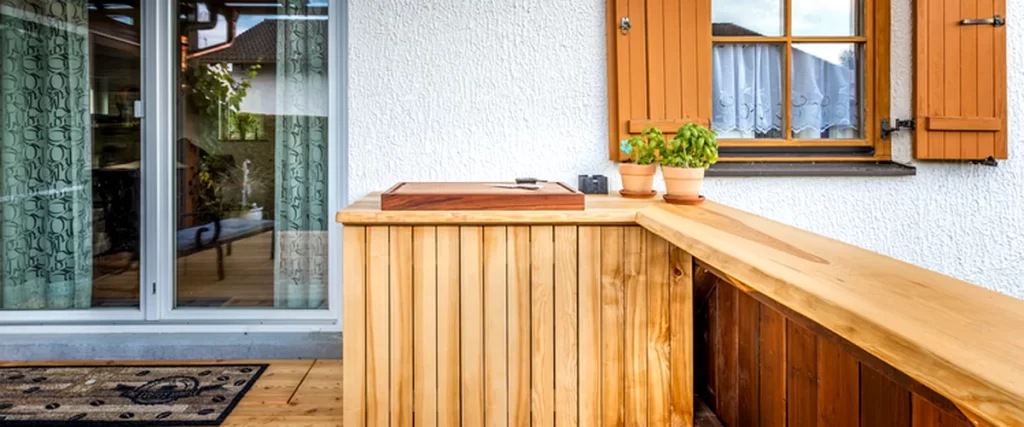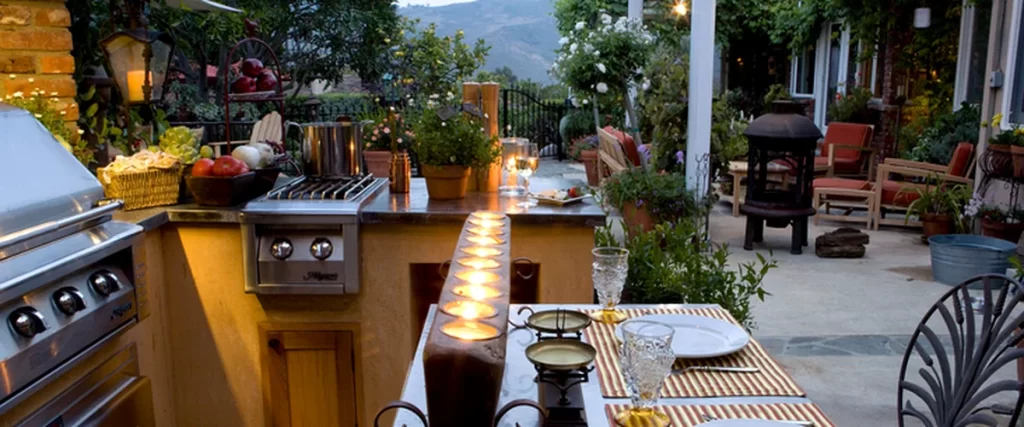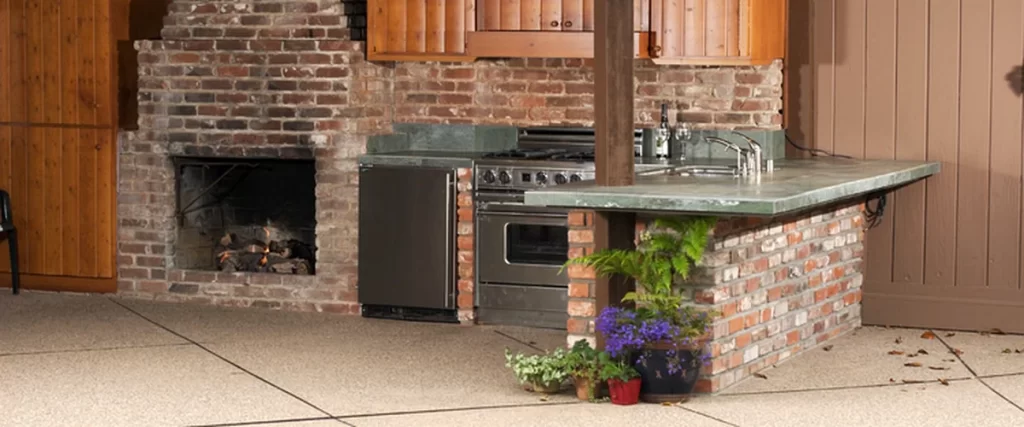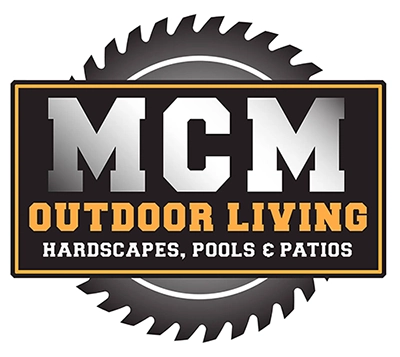Designing an outdoor kitchen is one of the most exciting projects for homeowners who love the great outdoors. It adds value to your property and creates a space where family and friends can gather to share meals and memories. Still, building a functional outdoor kitchen takes more than adding a grill and a countertop. Without the right plan, small oversights can turn into costly outdoor kitchen mistakes.
If you want your outdoor cooking area to stay beautiful, practical, and comfortable through the seasons, it helps to know what to avoid before you start. Here are some of the most common mistakes people make when designing outdoor kitchens, and how to plan for success.

1. Not Planning for Enough Counter Space
A grill alone doesn’t make a kitchen. One of the most common outdoor kitchen mistakes is forgetting how much counter space is needed for food preparation, serving, and cleanup.
When you start designing your layout, picture the steps of your cooking routine: seasoning meat, chopping vegetables, plating, or setting out drinks. If your counter space is too small, you’ll constantly move items back and forth between the house and the outdoor area. That’s inconvenient and breaks the flow of your outdoor cooking experience.
A functional outdoor kitchen should have:
- Ample counter space near the grill or cooktop
- A dedicated prep area separate from the main cooking zone
- Room for cutting boards, utensils, and serving dishes
Adding just a few extra feet of countertop can make a huge difference in how enjoyable your outdoor cooking feels.
2. Using Materials That Can’t Handle Outdoor Conditions
An outdoor kitchen faces everything nature throws at it: heat, rain, wind, and sometimes freezing temperatures. Using materials meant for indoor use is one of the biggest common mistakes homeowners make.
Outdoor conditions require weather-resistant materials that won’t crack, fade, or rust. Stainless steel appliances, for example, can handle humidity and heat better than standard indoor equipment. For countertops, durable materials like granite, concrete, or porcelain are better suited for outdoor use than laminate or marble.
You also want to make sure cabinet finishes and surfaces can handle the Texas sun. Choose durable materials that won’t peel or warp and that require minimal maintenance over time.
3. Ignoring Proper Ventilation
Outdoor kitchens still need proper ventilation, especially when they include covered structures or built-in grills. Without it, heat, grease, and smoke can build up quickly, damaging surfaces or making the space uncomfortable.
A high-quality range hood helps remove smoke and hot air from cooking zones, keeping the environment cooler and cleaner. This isn’t just about comfort, it’s also about safety. Good airflow protects both your outdoor appliances and your guests from excessive heat or lingering smoke.
If your outdoor kitchen is partially enclosed, plan for air circulation early in the design process. It’s easier to install vents before construction than after everything is finished.
4. Poor Lighting Choices
Lighting plays a major role in how your outdoor kitchen looks and functions. Many homeowners make the mistake of relying on a single light fixture or forgetting to include lighting altogether.
A successful design includes task lighting, ambient lighting, and accent lighting. Task lighting focuses on your prep areas and grill, giving you visibility when cooking at night. Ambient lighting creates a comfortable glow for dining or relaxing, while accent lights can highlight features like countertops, fire pits, or surrounding gardens.
Insufficient lighting can make it hard to cook safely after sunset, while harsh overhead bulbs can ruin the mood. Aim for a layered lighting plan that creates both visibility and atmosphere.
5. Overlooking Electrical and Utility Needs
An outdoor kitchen is more than a food place, it’s a mini hub for power and water. Forgetting about electrical outlets and proper utility connections is a mistake that can limit how you use the space later.
Think about the appliances you’ll plug in: blenders, mini-fridges, lighting systems, or outdoor TVs. Each needs a safe and weatherproof outlet. You may also need plumbing for a sink or gas lines for the grill and fire features.
Working with professionals ensures all your wiring and utilities meet safety codes and handle outdoor conditions. It’s one area where cutting corners can lead to costly repairs in the long run.

6. Not Providing Enough Shade or Shelter
Cooking outdoors under the open sky sounds wonderful until the midday sun makes it uncomfortable or rain interrupts dinner. Many people focus on appliances and finishes but forget to include shelter in their outdoor kitchen design.
Adding a pergola, pavilion, or retractable canopy provides shade and protects your surfaces and guests from direct sunlight. It also keeps your appliances cooler and extends their lifespan.
Shade structures enhance comfort and add architectural beauty to your outdoor area. They also make it possible to use the kitchen more often, no matter the weather.
7. Forgetting Storage
A great outdoor kitchen is as practical as it is beautiful. A common mistake to avoid is leaving out enough storage for utensils, cookware, cleaning supplies, and serving pieces.
Outdoor storage keeps everything within reach, saving you from repeated trips inside the house. Choose weather-resistant materials like stainless steel or sealed stone cabinetry that protect items from moisture and pests.
Include separate storage zones for cooking tools, spices, and extra fuel. When everything has its place, cooking and entertaining become much more enjoyable.
8. Placing Appliances in the Wrong Spot
Good layout planning is what turns a nice setup into a functional outdoor kitchen. Placing the grill or sink in the wrong position can make your cooking flow awkward and inefficient.
Follow a simple “work triangle” concept. The grill, sink, and prep counter should be close enough to move between easily but not so close that the space feels cramped. Keep hot appliances away from seating areas to prevent heat and smoke from reaching your guests.
Also, consider wind direction. A poorly placed grill can blow smoke toward the dining area or your house. Thinking through these details early helps you avoid frustration later.
9. Neglecting Comfort and Seating
A dream outdoor kitchen should feel as inviting as any room inside your home because it’s where you’ll linger over a drink, laugh with friends, and watch food come off the grill. Many homeowners get caught up in appliances and finishes, but skip the comfort and seating that make the space complete.
Include bar seating near the counter so guests can chat while food is being prepared. Add a dining area with enough room to move comfortably around tables and chairs.
Soft lighting, cushions, and a few decorative touches can turn your outdoor kitchen area into an inviting living space, not just a functional one.
10. Trying to Do Everything Yourself
Building an outdoor kitchen may look simple on paper, but the details add up fast. Plumbing, gas lines, permits, waterproofing, and material choices all require expertise. DIY approaches can lead to common pitfalls like poor drainage, uneven surfaces, or unsafe electrical work.
Professional builders understand how to create outdoor spaces that stay durable and safe under real outdoor conditions. They also help you balance aesthetics with functionality, ensuring your investment pays off in the long run.
If you want your project to last, partner with a team that knows how to handle outdoor construction from start to finish. You’ll save time, avoid mistakes, and get a result that looks and feels exactly right.
Creating Your Perfect Outdoor Kitchen
Every outdoor kitchen project begins with a vision. A place where you can cook, entertain, and enjoy the outdoors. Avoiding these common outdoor kitchen mistakes helps you design a space that works as beautifully as it looks.
It’s about combining the right layout, durable materials, good lighting, and thoughtful planning into a space that fits your lifestyle. When all these elements come together, the result is more than an outdoor kitchen. It’s an extension of your home.

Let the Experts Handle It
Designing and building an outdoor kitchen takes planning, coordination, and craftsmanship. It’s easy to underestimate how many details go into creating a safe, lasting, and beautiful outdoor area. Instead of managing permits, materials, and design layouts on your own, you can trust professionals who do this every day.
At MCM Outdoor Living, we design and build outdoor kitchens that bring people together. Our team knows how to choose durable materials, install appliances with precision, and create layouts that make outdoor cooking and entertaining simple.
If you’re ready to build your dream space and skip the stress of avoiding all these mistakes yourself, call us at (469) 583-6213 or message us here. We’ll help you create an outdoor kitchen that feels just right for your home and lifestyle.
